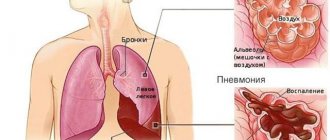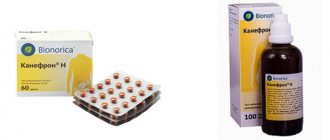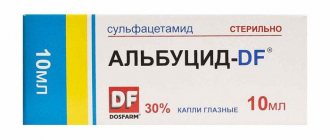Ceftriaxone
Hypersensitivity reactions
As with other β-lactam antibiotics, severe hypersensitivity reactions, some fatal, have been reported. If a severe hypersensitivity reaction develops, ceftriaxone therapy should be discontinued immediately and appropriate emergency treatment measures taken. Before starting therapy with ceftriaxone, it is necessary to determine whether the patient has had hypersensitivity reactions to ceftriaxone, cephalosporins, or severe hypersensitivity reactions to other β-lactam antibiotics (penicillins, monobactams and carbapenems).
Caution should be exercised when using ceftriaxone in patients with a history of mild hypersensitivity reactions to other β-lactam antibiotics (penicillins, monobactams and carbapenems).
Sodium content
1 g of the drug contains 3.6 mmol of sodium. This should be taken into account in patients on a sodium controlled diet.
Hemolytic anemia
As with the use of other cephalosporins, the development of autoimmune hemolytic anemia is possible during treatment with ceftriaxone. Cases of severe hemolytic anemia have been reported in adults and children, including deaths. If anemia develops in a patient being treated with ceftriaxone, the diagnosis of cephalosporin-associated anemia cannot be excluded and treatment must be discontinued until the cause is determined.
Diarrhea caused by Clostridium difficile
As with the use of most other antibacterial drugs, cases of diarrhea caused by Clostridium difficile (C. difficile )
, varying in severity: from mild diarrhea to fatal colitis.
Treatment with antibacterial drugs suppresses the normal microflora of the colon and provokes the growth of C. difficile.
In turn,
C. difficile
produces toxins A and B, which are factors in the pathogenesis of diarrhea caused by
C. difficile.
strains
of C. difficile
are infectious agents with a high risk of morbidity and mortality due to possible resistance to antimicrobial therapy, and treatment may require colectomy.
C. difficile
diarrhea in all patients with diarrhea after antibiotic therapy.
A thorough history taking is necessary, because There have been cases of diarrhea caused by C. difficile
occurring more than 2 months after antibiotic therapy.
C. difficile
diarrhea is suspected or confirmed , current non-
C. difficile
antibiotic therapy may need to be discontinued.
In accordance with clinical indications, appropriate treatment should be prescribed with the administration of fluids and electrolytes, proteins, antibiotic therapy for C. difficile, and
surgical treatment. Do not use medications that inhibit intestinal motility.
Superinfections
As with treatment with other antibacterial drugs, superinfections may develop.
Changes in prothrombin time
Rare cases of changes in prothrombin time have been described in patients receiving ceftriaxone. Patients with vitamin K deficiency (impaired synthesis, malnutrition) may require monitoring of prothrombin time during therapy and administration of vitamin K (10 mg/week) if the prothrombin time increases before or during therapy.
Formation of precipitates of ceftriaxone calcium salt
Cases of fatal reactions resulting from the deposition of ceftriaxone-calcium precipitates in the lungs and kidneys of newborns have been described. Theoretically, there is a possibility of interaction of ceftriaxone with calcium-containing solutions for intravenous administration in other age groups of patients, therefore ceftriaxone should not be mixed with calcium-containing solutions (including for parenteral nutrition), or administered simultaneously, incl. through separate access for infusions at different sites. Theoretically, based on the calculation of the 5 half-lives of ceftriaxone, the interval between the administration of ceftriaxone and calcium-containing solutions should be at least 48 hours. There are no data on the possible interaction of ceftriaxone with calcium-containing drugs for oral administration, as well as ceftriaxone for intramuscular administration with calcium-containing drugs (intravenously or orally).
After using ceftriaxone, usually in doses exceeding the standard recommended (1 g per day or more), ultrasound examination of the gallbladder revealed precipitates of the calcium salt of ceftriaxone, the formation of which is most likely in pediatric patients. Precipitates rarely cause any symptoms and disappear after completion or cessation of therapy with ceftriaxone. If these phenomena are accompanied by clinical symptoms, conservative non-surgical treatment is recommended, and the decision to discontinue the drug is left to the discretion of the attending physician and should be based on an individual assessment of benefit and risk.
Although there is evidence of the formation of intravascular precipitates only in neonates when using ceftriaxone and calcium-containing infusion solutions or any other calcium-containing drugs, ceftriaxone should not be mixed or prescribed to children and adult patients simultaneously with calcium-containing infusion solutions, even using different venous approaches (see sections " Contraindications", "Interaction with other drugs", subsection "Post-registration surveillance").
Pancreatitis
Rare cases of pancreatitis, possibly due to bile duct obstruction, have been described in patients receiving ceftriaxone. Most of these patients had preexisting risk factors for biliary congestion, such as prior therapy, severe illness, and total parenteral nutrition. At the same time, it is impossible to exclude the triggering role in the development of pancreatitis of precipitates formed under the influence of ceftriaxone in the biliary tract.
Use in children
The safety and effectiveness of ceftriaxone in neonates, infants, and young children have been determined at the dosages described in the Dosage and Administration section. Studies have shown that, like other cephalosporins, ceftriaxone can displace bilirubin from binding to serum albumin.
Ceftriaxone should not be used in newborns, especially premature infants, who are at risk of developing bilirubin encephalopathy (see section "Contraindications").
Long-term treatment
With long-term treatment, it is necessary to regularly monitor the peripheral blood picture, indicators of the functional state of the liver and kidneys.
Blood test monitoring
During long-term treatment, a complete blood count should be performed regularly.
Serological studies
When treated with ceftriaxone, false-positive results of the Coombs test, galactosemia test, and determination of glucose in urine may be observed (it is recommended to determine glucosuria only by the enzyme method).
Ceftriaxone por. 1g N1 fl. d/prig.v/v and i/m solution
Directions for use and dosage: For adults and children over 12 years of age: The average daily dose is 1-2 g of ceftriaxone once a day (every 24 hours). In severe cases or in cases of infections caused by moderately sensitive pathogens, the single daily dose can be increased to 4 g. For newborns, infants and children up to 12 years of age: For a single daily dosage, the following regimen is recommended: For newborns (up to two weeks of age): 20-50 mg/kg body weight per day (the dose of 50 mg/kg body weight is not allowed to be exceeded due to the immature enzyme system of newborns). For infants and children under 12 years of age: the daily dose is 20-75 mg/kg body weight. In children weighing 50 kg or more, the adult dosage should be followed. Doses greater than 50 mg/kg body weight should be administered as an intravenous infusion over at least 30 minutes. Duration of therapy: depends on the course of the disease. Combination therapy: Experiments have proven that there is synergism between ceftriaxone and aminoglycosides in their effect on many Gram-negative bacteria. Although the potentiated effect of such combinations cannot be predicted in advance, in cases of severe and life-threatening infections (for example, those caused by Pseudomonas aeruginosa), their combined use is justified. Due to the physical incompatibility of ceftriaxone and aminoglycosides, they must be prescribed separately in recommended doses! Meningitis: For bacterial meningitis in newborns and children, the initial dose is 100 mg/kg body weight once a day (maximum 4 g). Once the pathogenic microorganism has been isolated and its sensitivity has been determined, the dose must be reduced accordingly. The best results were achieved with the following periods of therapy:
Pathogen Duration of therapy Neisseria meningitides 4 days Haemophilus influenzae 6 days Streptococcus pneumoniae 7 days Sensitive Enterobacteriacease 10 -14 days
Gonorrhea: For the treatment of gonorrhea caused by both penicillinase-forming and non-penicillinase-forming strains, the recommended dose is 250 mg once intramuscularly. Prevention in the pre- and postoperative period: Before infected or suspected infected surgical procedures, to prevent postoperative infections, depending on the danger of infection, a single administration of ceftriaxone in a dose of 1-2 g is recommended 30-90 minutes before surgery. Insufficiency of kidney and liver function: In patients with impaired renal function, provided that liver function is normal, there is no need to reduce the dose of ceftriaxone. Only in case of renal failure in the preterminal stage (creatinine clearance below 10 ml/min) is it necessary that the daily dose of ceftriaxone does not exceed 2 g. In patients with impaired liver function, provided that renal function is preserved, there is also no need to reduce the dose of ceftriaxone. In cases of simultaneous presence of severe liver and kidney pathology, the concentration of ceftriaxone in the blood serum must be regularly monitored. In patients undergoing hemodialysis, there is no need to change the dose of the drug after this procedure. Intramuscular administration: For intramuscular administration, 1 g of the drug must be diluted in 3.5 ml of a 1% solution of Lidocaine and injected deep into the gluteal muscle; it is recommended to inject no more than 1 g of the drug into one buttock. Lidocaine solution should never be administered intravenously! Intravenous administration: For intravenous injection, 1 g of the drug must be diluted in 10 ml of sterile distilled water and administered intravenously slowly over 2-4 minutes. Intravenous infusion: Duration of intravenous infusion is at least 30 minutes. For intravenous infusion, 2 g of powder must be diluted in approximately 40 ml of a calcium-free solution, for example: 0.9% sodium chloride solution, 5% glucose solution, 10% glucose solution, 5% levulose solution.
Side effects: Systemic side effects: from the gastrointestinal tract (about 2% of patients): diarrhea, nausea, vomiting, stomatitis and glossitis. Changes in the blood picture (about 2% of patients) in the form of eosinophilia, leukopenia, granulocytopenia, hemolytic anemia, thrombocytopenia. Skin reactions (about 1% of patients) in the form of exanthema, allergic dermatitis, urticaria, edema, erythema multiforme. Other rare side effects: headaches, dizziness, increased liver enzymes, gallbladder congestion, oliguria, increased serum creatinine, mycoses in the genital area, chills, anaphylaxis or anaphylactic reactions. Pseudomembranous enterocolitis and blood clotting disorders are extremely rare. Local side effects: After intravenous administration, phlebitis was noted in some cases. This phenomenon can be prevented by slow (over 2-4 minutes) administration of the drug. The described side effects usually disappear after stopping therapy.





